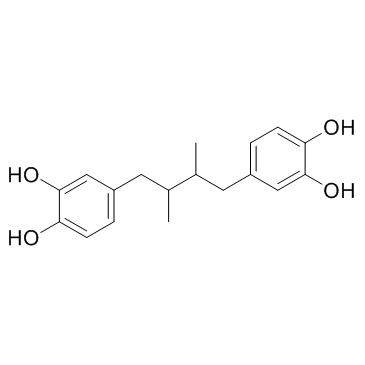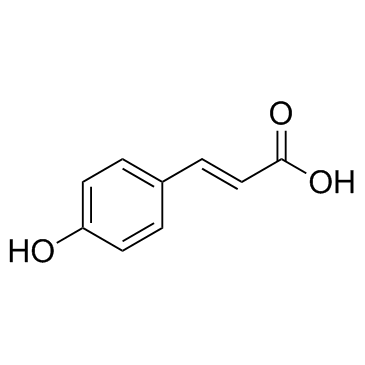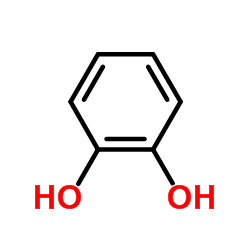500-38-9
| Name | nordihydroguaiaretic acid |
|---|---|
| Synonyms |
1,2-Benzenediol, 4-[(2R,3S)-4-(3,4-dihydroxyphenyl)-2,3-dimethylbutyl]-
meso-4,4'-(2,3-Dimethyltetramethylene)dipyrocatechol MFCD00002206 1,4-Bis(3,4-dihydroxyphenyl)-2,3-dimethylbutane Nordihydroguaiaretic acid Nordihydroguaiaretic acid (meso-form) MESO-NORDIHYDROGUAIARETIC ACID Nordihydroguairaretic acid 4,4'-(2,3-Dimethyltetramethylene)dipyrocatechol Actinex NDGA 4-[(2R,3S)-4-(3,4-Dihydroxyphenyl)-2,3-dimethylbutyl]-1,2-benzenediol b,g-Dimethyl-a,d-bis(3,4-dihydroxyphenyl)butane Masoprocol 4-[(2R,3S)-4-(3,4-Dihydroxyphenyl)-2,3-dimethylbutyl]benzene-1,2-diol 1,2-Benzenediol,4,4'-(2,3-dimethyl-1,4-butanediyl)bis- Nordihydro Guaiaretic Acid EINECS 207-903-0 |
| Description | Nordihydroguaiaretic acid is a 5-lipoxygenase (5LOX) (IC50=8±3 μM) and tyrosine kinase inhibitor. |
|---|---|
| Related Catalog | |
| Target |
IC50: 8±3 μM (5LOX)[1] |
| In Vitro | The natural dicatechol Nordihydroguaiaretic acid (NDGA) is a selective 5LOX inhibitor from the creosote plant (Larrea tridentata: Zygophyllaceae). The 5LOX-inhibiting natural dicatechol Nordihydroguaiaretic acid is a very effective, non-toxic antagonist of TNFα-stimulated microglial activation. Nordihydroguaiaretic acid is approximately six times more potent than Minocycline in vitro, with an IC50 value of 8±3 μM and no toxicity at 100 μM. Significant NO2- suppression is observed at 800 nM Nordihydroguaiaretic acid. Similar efficacy is observed for natural and synthetic Nordihydroguaiaretic acid, as well as for the acetyl ester of Nordihydroguaiaretic acid. Nordihydroguaiaretic acid also suppresses TNFα-stimulated PGE2 production by EOC-20 cells with an IC50 of 841 nM[1].To test the proliferation effect of prostaglandin E1 and Nordihydroguaiaretic acid (NDGA) on cancer cell lines, HepG2 cell lines are treated with various doses of the two compounds and the positive compounds 8-anilino-1-naphtalene sulfonate (ANS), respectively, for 24 h and cell viability is examined by the MTT assay. ANS displays a dose-dependent inhibition (0, 10, 30, 50, 80, 100, 120, and 150 μM) with the estimated IC50 being 25.888 μM. The tested IC50 of prostaglandin E1 is 41.223 μM and Nordihydroguaiaretic acid is 45.646 μM, respectively, at different concentrations of 0, 30, 60, 80, 100, 120, and 140 μM[2]. |
| In Vivo | Compared with the control ob/ob chow diet group, there is a significant reduction of body weight starting from 9 wk treatment in the high-dose Nordihydroguaiaretic acid (NDGA) diet group, and from 12 wk in the low-dose group. Nordihydroguaiaretic acid treatment results in higher body (rectal) temperatures of ob/ob mice, especially with the high dose of Nordihydroguaiaretic acid[3]. |
| Cell Assay | MTT assay is used to measure cell growth-inhibitory activity of the selected most promising compounds in HepG2 cell lines. Cells are cultured in 96-well culture plate at 1×104 cells/well. After 24 h cultured at 37 °C in the atmosphere of 5% CO2, cells are adhered and treated with different concentrations of the targeted compounds (e.g., Nordihydroguaiaretic acid, 0, 30, 60, 80, 100, 120, and 140 μM) and incubated for 24 h. Then, the supernatants are discarded and MTT (0.5 mg/mL) is added to each well and incubated at 37°C in 5% CO2 for an additional 4 h. Following, the MTT is removed and 150 μL of formazan in DMSO is added to terminate response and then plates are set to the table shaker for 5 min at low speed. Cell proliferation is evaluated by measuring the absorbance at 570 nm using ELISA Plate Reader. The IC50 values are calculated by SPSS statistics 17.0[2]. |
| Animal Admin | Mice[3] Seven-week-old male control C57BL/6J mice, male leptin-deficient (ob/ob) mice, and male Pparα-deficient mutant mice (B6.129S4-Pparatm1Gonz/J) are used. These mice are fed a standard chow diet for 1 wk to allow them to acclimatize to a controlled new environment (25±2°C, 55±5% relative humidity with a 12-h light-dark cycle). Subsequently, one group of ob/ob mice is switched to a chow diet supplemented with either low- (0.83 g/kg chow diet) or high-dose (2.5 g/kg chow diet) Nordihydroguaiaretic acid and maintained on this diet for 16 wk. The other groups of ob/ob mice and control mice continue to be fed a normal chow diet for 16 wk. In another set of studies, C57BL/6J mice and Pparα-deficient mutant mice are fed either a high-fat diet (~60% of total calories come from fat), or the same high-fat diet supplemented with a high dose of Nordihydroguaiaretic acid (2.5 g/kg diet). Food intake and body weights are measured once a week throughout the experiment. |
| References |
| Density | 1.2±0.1 g/cm3 |
|---|---|
| Boiling Point | 526.5±45.0 °C at 760 mmHg |
| Melting Point | 184-189ºC |
| Molecular Formula | C18H22O4 |
| Molecular Weight | 302.365 |
| Flash Point | 247.8±23.3 °C |
| Exact Mass | 302.151794 |
| PSA | 80.92000 |
| LogP | 3.71 |
| Vapour Pressure | 0.0±1.4 mmHg at 25°C |
| Index of Refraction | 1.627 |
| Storage condition | Freezer (-20°C) |
| Stability | Stable. Incompatible with oxidizing agents. |
| Water Solubility | slightly soluble |
CHEMICAL IDENTIFICATION
HEALTH HAZARD DATAACUTE TOXICITY DATA
MUTATION DATA
|
| Symbol |

GHS07 |
|---|---|
| Signal Word | Warning |
| Hazard Statements | H302-H315-H319-H335 |
| Precautionary Statements | P261-P305 + P351 + P338 |
| Personal Protective Equipment | dust mask type N95 (US);Eyeshields;Gloves |
| Hazard Codes | Xn:Harmful; |
| Risk Phrases | R22;R36/37/38 |
| Safety Phrases | S26-S37/39 |
| RIDADR | NONH for all modes of transport |
| WGK Germany | 3 |
| RTECS | UX1750000 |
| HS Code | 2907299090 |
|
~% 
500-38-9 |
| Literature: Palacio, Lorena; Cantero, Juan Jose; Cusido, Rosa; Goleniowski, Marta Process Biochemistry, 2011 , vol. 46, # 1 p. 418 - 422 |
| HS Code | 2907299090 |
|---|---|
| Summary | 2907299090 polyphenols; phenol-alcohols。supervision conditions:AB(certificate of inspection for goods inward,certificate of inspection for goods outward)。VAT:17.0%。tax rebate rate:9.0%。MFN tariff:5.5%。general tariff:30.0% |



